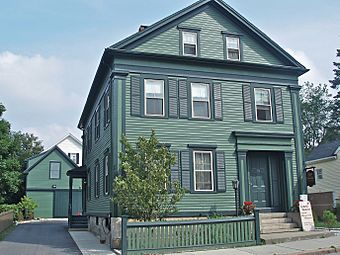Corky Row Historic District facts for kids
Quick facts for kids |
|
|
Corky Row Historic District
|
|

Andrew Borden House, 230 Second Street, part of Corky Row Historic District
|
|
| Location | Fall River, Massachusetts |
|---|---|
| Architectural style | Early Republic, Greek Revival |
| MPS | Fall River MRA |
| NRHP reference No. | 83000656 |
| Added to NRHP | June 23, 1983 |
The Corky Row Historic District is a special area in Fall River, Massachusetts. It's like a time capsule, showing what the city was like long ago. This district is bordered by Plymouth Avenue, Interstate-195, and Second Street. You'll find many old apartment buildings here, built for mill workers. There are also historic factories like the Davol Mills and Tecumseh Mill No. 1, plus some old shops.
One of the most well-known buildings in Corky Row is the Andrew J. Borden House. It's located at 230 Second Street. This historic district covers about 96 acres and has over 400 old buildings. It was added to the National Register of Historic Places in 1983, which means it's recognized as an important historical place.
Contents
A Look Back at Corky Row's History
The Corky Row neighborhood grew a lot between 1840 and 1870. This was a big time of growth for the city of Fall River. Many people from County Cork, Ireland, came to live here. They moved to Fall River to work in the busy textile mills. These mills made fabric and were a huge part of the city's economy.
Homes for Mill Workers
The historic district has many apartment buildings. These include four-family and six-family homes. You can also see classic New England-style triple deckers. Many of these homes were built by the new cotton mills in the 1860s. These mills included the Tecumseh, Davol, and Robeson Mills. They were located near Hartwell Street, on the eastern side of the district.
Corky Row Today
Today, Corky Row is a mix of homes and businesses. You can see newer buildings along Plymouth Avenue and Hartwell Street. There are also new developments on Second and Rodman Streets. The old Tecumseh Mill was turned into apartments in the 1980s. The Robeson Mills were taken down in the 1990s. Now, you'll find modern stores like Applebee's and Walgreens where they once stood.
Community Spirit
The Corky Row Club is an important part of the neighborhood. It's on Third Street and started in 1938 as an Irish social club. There's also the James T. Griffin playground nearby. This playground is named after a local hero. James T. Griffin was one of the first people from the area to die in World War II.
Important Buildings in Corky Row
Many buildings in Corky Row are considered "contributing properties." This means they help tell the story of the district's history.
Historic Mills
- Davol Mills (built in 1866 and 1872), located on Rodman Street & Plymouth Avenue.
- Tecumseh Mill No.1 (built in 1866), located on Hartwell Street.
Notable Houses
- Andrew J. Borden House (built in 1845), at 230 Second Street.
- Benjamin Kellogg House (built in 1874), at 14-20 Brow Street.
- Tecumseh Mill Housing (built in 1866), at 300-308 Fifth Street.
- Davol Mill Housing (built in 1870), at 367-371 Fifth Street.
- Moses Dean House (built in 1877), at 201-203 Fourth Street.
- Jeremiah Shea House (built in 1885), at 486 Fourth Street.
- Thomas Gormley House (built in 1881), at 825 Plymouth Avenue.
Shops and Other Buildings
- Giesow Building (built in 1894), at 120 Third Street.
- Flat Iron Building (built in 1908), at 878-892 Second Street.
- St. Mary's School (built in 1906), at 467 Spring Street.
- Neill's Hotel (built in 1899), at 255 Third Street.
Images for kids








